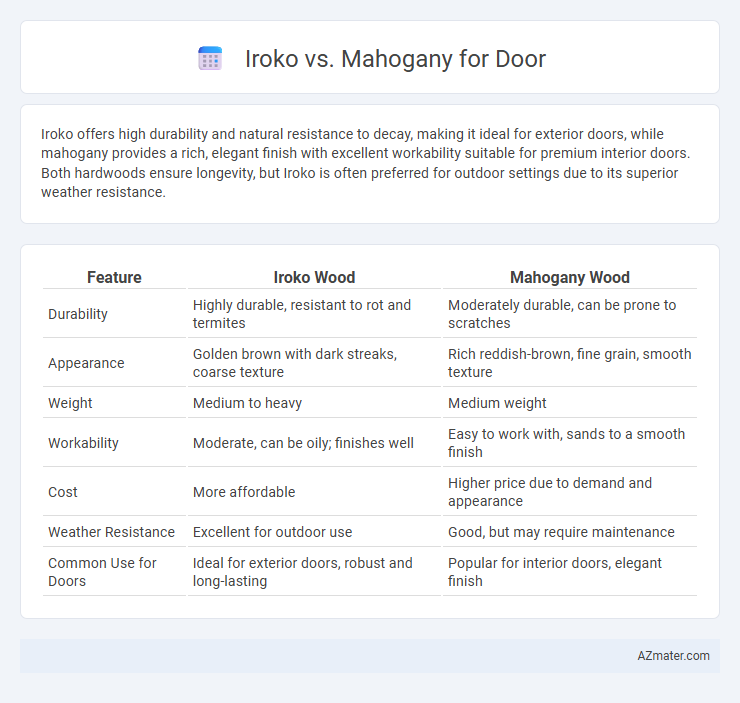Iroko offers high durability and natural resistance to decay, making it ideal for exterior doors, while mahogany provides a rich, elegant finish with excellent workability suitable for premium interior doors. Both hardwoods ensure longevity, but Iroko is often preferred for outdoor settings due to its superior weather resistance.
Table of Comparison
| Feature | Iroko Wood | Mahogany Wood |
|---|---|---|
| Durability | Highly durable, resistant to rot and termites | Moderately durable, can be prone to scratches |
| Appearance | Golden brown with dark streaks, coarse texture | Rich reddish-brown, fine grain, smooth texture |
| Weight | Medium to heavy | Medium weight |
| Workability | Moderate, can be oily; finishes well | Easy to work with, sands to a smooth finish |
| Cost | More affordable | Higher price due to demand and appearance |
| Weather Resistance | Excellent for outdoor use | Good, but may require maintenance |
| Common Use for Doors | Ideal for exterior doors, robust and long-lasting | Popular for interior doors, elegant finish |
Introduction to Iroko and Mahogany
Iroko, a durable hardwood native to West Africa, is prized for its golden to medium brown color and exceptional resistance to rot and insects, making it ideal for exterior doors. Mahogany, hailing from tropical regions of Central and South America, is renowned for its rich reddish-brown hue and smooth texture, offering elegance and strength for high-end interior or exterior doors. Both woods provide excellent stability and longevity, with Iroko favored for rugged, weather-resistant applications and Mahogany prized for its luxurious appearance and fine grain.
Botanical Origins and Wood Characteristics
Iroko wood, derived from Chlorophora excelsa native to West Africa, features a coarse texture with a golden to medium brown hue that darkens over time, known for its high natural oil content enhancing durability and resistance to decay. Mahogany, primarily from Swietenia macrophylla in Central and South America, is prized for its fine, straight grain and rich reddish-brown color that deepens with age, offering excellent workability and dimensional stability. Both woods exhibit high strength and moisture resistance, but Iroko's natural oils provide superior outdoor performance, making it suitable for exterior doors, while Mahogany's refined appearance suits high-end interior doors.
Durability and Resistance to Elements
Iroko wood offers exceptional durability with high resistance to rot, insects, and moisture, making it ideal for exterior doors exposed to harsh weather conditions. Mahogany, known for its strength and stability, provides good resistance to decay and warping but typically requires regular maintenance to retain its protective qualities. Both woods perform well in outdoor environments, though Iroko's natural oils give it a slight advantage in long-term resistance to elements like rain and UV exposure.
Appearance and Color Comparison
Iroko wood features a golden to medium brown hue that darkens with age, displaying an attractive grain pattern that ranges from interlocked to straight, ideal for doors seeking a warm, natural look. Mahogany offers a rich, deep reddish-brown color with a fine, straight grain that exudes classic elegance and sophistication, frequently preferred for high-end door designs. Both woods provide durability and aesthetic appeal, but Iroko's lighter, more varied tones contrast with Mahogany's consistently darker, polished finish, influencing the visual impact of entry doors.
Workability and Ease of Installation
Iroko offers excellent workability due to its medium density and straight grain, allowing smooth cutting, drilling, and shaping, making it ideal for detailed door fabrication. Mahogany is slightly softer with a fine, even texture, which enhances ease of installation by reducing the risk of splitting and allowing for secure fastening. Both woods provide durability, but Iroko's higher hardness requires sharper tools, whereas Mahogany demands less effort during installation, optimizing efficiency on-site.
Cost and Availability
Iroko wood is generally more affordable and readily available compared to Mahogany, making it a popular choice for cost-conscious door projects. Mahogany doors, prized for their rich appearance and durability, tend to be more expensive due to limited availability and slower growth rates. Availability of Iroko is higher in African regions, while Mahogany's supply is more restricted, impacting overall pricing and procurement ease.
Maintenance Requirements
Iroko wood requires moderate maintenance as it is naturally resistant to rot and insects but benefits from regular oiling to maintain its durability and appearance. Mahogany demands higher maintenance due to its susceptibility to scratches and fading, needing periodic sanding and refinishing to preserve its rich color and smooth finish. Both woods require protective treatments against moisture to prevent warping, but Iroko generally offers greater long-term resilience with less upkeep.
Environmental Impact and Sustainability
Iroko wood, sourced primarily from West Africa, is considered more sustainable due to faster growth rates and better forest management practices compared to Mahogany, which often comes from slow-growing, endangered tropical species in South America. The harvesting of Mahogany has led to significant deforestation and habitat loss, making it a less environmentally friendly choice for doors. Choosing Iroko supports sustainable forestry, reduces carbon footprint, and helps preserve biodiversity, aligning with eco-conscious building practices.
Best Use Cases for Doors
Iroko wood is highly durable and resistant to rot and insects, making it ideal for exterior doors exposed to harsh weather conditions. Mahogany offers a rich, deep color and fine grain, perfect for elegant interior doors where aesthetic appeal is a priority. For heavy-traffic doors requiring strength and longevity, Iroko provides superior toughness, while Mahogany excels in upscale settings demanding refined finishes.
Conclusion: Which Wood is Better for Doors?
Iroko and Mahogany both offer exceptional durability and aesthetic appeal for doors, but Mahogany's rich reddish-brown hue and fine grain provide superior elegance and workability, making it a preferred choice for high-end interiors. Iroko's natural resistance to moisture and decay suits external doors exposed to harsh weather conditions, ensuring long-lasting performance. Choosing between Iroko and Mahogany depends on specific needs: Mahogany excels in premium indoor installations, while Iroko stands out for sturdy, weather-resistant exterior doors.

Infographic: Iroko vs Mahogany for Door
 azmater.com
azmater.com